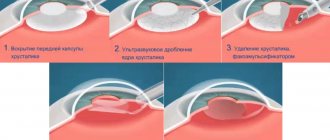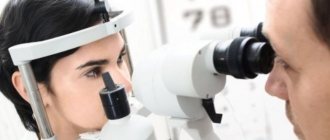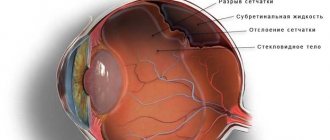This is what a model of an intraocular multifocal lens from Carl Zeiss looks like. The actual size of such a lens is 11 millimeters, the diameter of the optical zone is 6 mm. To put it simply, a cataract is age-related clouding and hardening of the lens.
According to the classical definition, we are talking specifically about opacities of any type. First, something gets in the way in your field of vision, a general “fog” appears, you want to wipe your dirty glasses, then you don’t see the letters in the book, then you want to turn on the light brighter or, conversely, you hide from the bright light, and then you wake up one fine morning and understand that you can’t find slippers. And you don’t see anything at all - only shadows. This process sometimes drags on for many years, but the slippers will still be lost. Mentions of cloudiness developing in the eyeball can be found thousands of years before our era.
The treatment procedure has historically been very unique - reclination of the cloudy lens. The doctor saw a patient with a very dense lens - so dense that the patient was already blind. During excavations of settlements of Ancient Greece and Rome, tools were found that doctors used to remove cataracts - sharp needles that pierced the eye and lens, destroying its supporting apparatus. The lens could come off and, due to its gravity, fall down also from being hit on the back of the head with a heavy stick several times. Sometimes the patient died during emergency ophthalmological care, sometimes he received a concussion, and sometimes the lens broke off the ligaments and flew deep into the eye. The patient began to see again - he had a huge bump and vision of about +10 +15 diopters.
Now two news. The bad news is that people are increasingly living to see cataracts, and they are inevitable. Good - we have something better than sharp needles and a heavy stick.
What happens to the lens as you age?
If you have read previous posts, you are already very familiar with the cornea. This is the first most powerful refractive lens of the eye; it is formed at approximately 16–18 years of age and changes slightly throughout life. Next we have the second “group of lenses” - lenses (lens - natural lens in English terminology). And behind it, through the vitreous body, there is a sensor, that is, the retina.
The lens is responsible for the refraction of light (about +20 diopters at rest and about +30 diopters when stressed) and focusing the eye. When we look at a book, the muscles tense and shape it so that the focus falls on the letters. When we look at a plane in the sky, the muscles relax and the lens forms almost parallel rays. The muscles are not located in the lens itself, but in the area of the so-called ciliary body; the lens ligaments are attached to them, which, in turn, allows for accommodation, that is, this precise adjustment to the desired focal length by changing the shape of the lens. If you take out the lens at all, you will see with glasses somewhere between +10 and +15 diopters.
With age, the lens gradually becomes dense and cloudy. In a young person, the lens usually contains only 60–65% tissue water. In old age, the amount of fluid decreases. Although the lens “floats” in liquid, it itself is relatively dry. On the other hand, in the lens itself, due to its structure and the absence of blood vessels, there are no tumor or inflammatory processes. The lens does not hurt because it has no nerve endings.
Often, as cataracts develop, they cause a weakening of presbyopia and the ability to read without glasses, that is, two age-related pathologies suddenly correct each other. But this is an imaginary improvement in vision, the image quality is poor - this is a significant symptom of the development of cataracts.
At about 60–70 years of age, the lens completely loses its ability to accommodate, that is, it becomes hard, large and inelastic. The lens also turns yellow with age.
Yes, it must be said that cataracts are not necessarily an age-related phenomenon. There are congenital cataracts (if during pregnancy a woman suffers from certain infectious, systemic or genetic diseases).
There are complicated types of cataracts that appear with concomitant diseases of the eyes or the body as a whole, for example, diabetes, arthritis, etc. Taking certain medications can also cause cataracts.
And, of course, any injury to the eye can cause cataracts, even if there was no direct contact with the lens. It is now known that cataracts are caused by strong infrared radiation, as well as various radiation factors, and not immediately, but years later. This, in particular, calls into question the use of powerful lidars of unmanned vehicles operating in the infrared spectrum - while their effect on the eyes has not been studied in the future for several years. It is also known that ultrahigh frequency current also leads to the development of cataracts. Cataracts can also be caused by poisoning, in particular (very typical) with nitro paint. In animals, cataracts have been learned to be produced predictably with naphthalene and specific diets.
But let's return to ordinary age-related cataracts. A very characteristic symptom of the beginning of the process is that the patient thinks that his glasses are “dirty”, and there is a constant desire to wipe them. If you suddenly notice this in an elderly relative, it means it’s definitely time to change the lens.
Sometimes patients misinterpret the symptoms that appear. Very often, cataracts mature by thickening the lens - along the sclerotic path. In this case, the patient with cataracts, who was reading with glasses, suddenly begins to notice with surprise that he can now see poorly with them and it becomes possible, albeit in the “fog,” to read the text without glasses. The patient feels joy and thinks that he can see better. Alas, this is a bad symptom! He says you need to schedule a visit to the ophthalmologist.
Often cataracts cause myopia, which has been stable for years, to suddenly begin to worsen. Sometimes to enormous values - -20 diopters or more. In general, frequent changes of glasses are an early sign of cataracts.
The second option for cataract maturation is no better - hydropic, when the lens begins to increase in volume, becomes waterlogged, swells and leads to an increase in intraocular pressure and rapid loss of vision.
There are also a number of symptoms: at dusk it becomes better to see than during the day, rainbows and double vision are disturbing, astigmatism appears or increases. In general, cataracts are very diverse in their manifestations; it is impossible to make a diagnosis on your own; this requires a visit to an ophthalmologist.
Cataracts at a young age - causes and treatment
Cataracts are called the most common eye disease in mature and elderly people. Due to the serious decrease in visual acuity that this disease causes, professional activities may be complicated and restrictions may arise in the self-care of citizens, and in advanced cases, blindness may occur. However, cataracts are not a death sentence. And with a timely visit to an ophthalmologist, high-quality treatment of the disease is possible, which will allow a person to restore maximum vision and quickly return to a traditional lifestyle.
When is the lens removed?
There are three types of indications for lens replacement: optical, refractive and medical.
Optical readings are when the aging and compaction of the “onion” in layers has reached its logical end and the lens darkens. When cataracts begin to reduce vision qualitatively or quantitatively. Feelings as if smoked glass had been inserted into the eye or as if you were looking at the world through glass splattered with semolina. Even initial cataracts, which cause decreased vision, require removal.
The old term “immature” is not a reason to wait for ripening. A diagnosis of cataract is a reason to replace the lens.
When a person no longer sees objects and only light perception remains, this is the last stage of mature cataracts. It is better not to bring it to this point, in particular because changes in the lens cause numerous disruptions in the normal functioning of the eye. In mature and overripe forms, the lens capsule and ligamentous apparatus suffer; removal requires a large amount of ultrasonic energy, which, in turn, destroys the cornea and its delicate endothelial layer. In general, if you delay replacing the lens, you should be prepared for the fact that the operation will be longer and more traumatic, with a long recovery period.
Refractive readings are changes in the optics of the eye. By replacing the lens and correct calculations of the optical power of the implanted artificial lens, we can change the refraction of the eye to the desired value - save the patient from a large “minus” or “plus”, correct astigmatism, and get rid of age-related farsightedness. In this case, cataracts do not develop, and the optics of the eye remain stable forever.
This method is most often used for patients over 40-45 years of age, when the first symptoms of presbyopia appear.
Medical indications are when your own lens is the cause of concomitant changes in the eye, for example, when there is a subluxation after an injury and there is a risk of its dislocation, when it causes the formation of glaucoma (a dangerous increase in intraocular pressure and death of the optic nerve), etc. That is, again, to simplify, sooner or later the lens will still need to be changed, but due to the risk of pathologies, sometimes it needs to be changed a little earlier than it has exhausted its resource.
Causes of the disease
Normally, the human lens is completely transparent. It contains water, proteins and some minerals. The lens is nourished by intraocular moisture, which is produced in the eye. With age, metabolic products that have a toxic effect accumulate in the intraocular fluid. Thus, a nutritional disorder occurs, and the lens gradually loses its former transparency. The typical variety of cataracts is very extensive, which is due to the differences in the resulting opacities of the lens.
In addition to age, the formation of opacities is influenced by a number of eye diseases and pathologies of other organs. The cataracts that arise in this case are called complicated; they can develop against the background of glaucoma, myopia, diseases of the choroid, retinal detachments and pigmentary dystrophies.
Often the cause of clouding of the lens is also common diseases: diabetes, blood and joint diseases, bronchial asthma, skin diseases (such as eczema or psoriasis).
The development of cataracts is also influenced by some external factors: poor nutrition, vitamin deficiency (calcium, vitamin C), occupational hazards, ultraviolet radiation and radiation, polluted environment, smoking.
Should we wait until the patient becomes completely blind?
Patients often use this logic: as long as the eye sees something, there is no need to operate on the lens.
In fact, today, on the contrary, the lens is operated on as early as possible, when it is already clear that an irreversible process has begun. The reason - in addition to protection from risks caused by changes in metabolism in the eye, is that the softer the lens is at the time of surgery, the less invasive the method will be used, and the lower the risk of complications. The pooled worldwide risk of severe to serious complications from lensectomy is around 6%. In the case of late stages, it can reach 20–30%. In the early stages it is 1–2%. In the case of using modern access equipment, very precise selection of the lens-implant itself and more than 5 years of experience of the surgeon - less than 1%. What influences the risks so much, I will tell you in the next post, when we talk directly about the progress of the operation.
Another important point is that you yourself will never be able to determine on your own what condition your lens is in. There are a number of factors that force surgeons to recommend surgery at an earlier stage: weak ligamentous apparatus of the lens, short or, conversely, long eyes, eyes with a shallow anterior chamber, the condition of the corneal endothelium and other things that can only be assessed by a specialist who performs operations on this particular subject. type. Quite often, outpatient doctors act as advisors, but they are not always well versed in the surgical technique and the indications for lens replacement. By reassuring the patient with the words “you have an immature cataract, it’s too early to operate,” they do the patient a “disservice” - inaction leads to the optimal time being missed.
In general, cataract surgery in ophthalmology is like appendicitis surgery in general surgery. It is considered the most basic and most predictable in the standard case, the most creative in the non-standard case. If everything goes according to the scenario, even an inexperienced surgeon will get a good result. If something goes wrong (and this cannot always be predicted in advance), then only an experienced surgeon will be able to find a way out of the unusual situation. I have to very often, almost weekly, undergo reconstructive surgeries after unsuccessful surgeries in other clinics. Sometimes the volume of such surgery is enormous - operations lasting not 10-15 minutes (as with standard cataracts), but 1-2 hours of “creativity”.
An important point in cataract surgery is the choice of lens. And the main factor is taking into account the individual characteristics of a particular patient. Models of IOLs (intraocular lenses) differ in the material of manufacture, the shape and number of supporting elements, the structure of the optics (spherical, aspherical, astigmatic), and the method of attachment. Therefore, it is better to choose not an American or German one, “like your neighbor’s,” but the one that your surgeon considers most suitable for your eye.
And the most important. Lens replacement restores optical clarity and may improve the optics of the eye, but it will not create a new eye. If there are concomitant problems with the retina, optic nerve, cornea or brain, that is, there are other problems with vision loss, then these will ultimately determine how you see after surgery. That is, post-operative visual acuity will be as you visual analyzer as a whole.
Surgery
Symptoms of early cataracts can be alleviated with new glasses and stronger lighting. Anti-reflective coating on glasses also helps a lot when driving at night.
However, once the disease has progressed to the point where visual impairment reduces a person's quality of life and interferes with daily activities, surgery is the only effective treatment.
The incisions are often made using a hand-held microscopic blade, but modern laser surgery allows them to be made under precise computer control. Laser cataract surgery should not be confused with techniques such as PRK or LASIK, which are used to correct vision.
There are two main methods of surgical treatment:
- Extracapsular surgery
A 10-12mm incision is made in the front of the eye and the lens is removed. The posterior capsule remains in place to support the new intraocular lens (IOL), also called an artificial lens. The incision in the eye is then closed using tiny invisible stitches. This method is now considered outdated and is rarely used anywhere.
- Phacoemulsification
This is a more modern method. The surgeon makes a small incision near the border of the cornea and sclera, or in the cornea itself. A tiny probe that emits ultrasound waves is inserted into the lens capsule to break it into pieces. The parts are carefully sucked out. The much smaller incision required for this method has the advantage of reduced healing time.
Phacoemulsification of cataracts can be performed with femto-assistance. Those. the lens will be destroyed not with the help of a probe and ultrasound, but with the use of a femtosecond laser, which is called femtocataract. This method offers a number of advantages, providing greater accuracy and reducing recovery time. But at the same time, it is distinguished by its high cost, since the price almost doubles compared to conventional phacoemulsification.
Recovery
Patients are usually sent home after spending several hours in a clinic or hospital.
There is typically mild soreness and discomfort after cataract surgery. This can usually be reduced with drugs such as paracetamol.
It may take a day or two for the eyes to sync. Vision then usually improves quickly and the person can return to full normal activities within about two weeks. Distance vision returns; glasses will be needed for close work and reading.
Where is the best place to have surgery?
The following is important: “planned” lens replacement is included in the compulsory medical insurance package.
The patient always has the right to choose: whether to go to the nearest territorial clinic for a referral to a budget institution or to come for diagnostics and surgery to a paid clinic. To the question “where is it better?” there is no single answer. Everyone chooses based on their life experience, advice from friends, financial situation, mobility and much more. There is one piece of advice when choosing the compulsory medical insurance option: if you are offered to buy a lens or all the “consumables” in general, citing the fact that the hospital does not have lenses or something else, then you should know that you are being deceived. The compulsory medical insurance system does not involve co-financing, that is, if you receive a service under a compulsory medical insurance policy, then everything should be free for the patient, including lenses, solutions, etc. Or everything is paid. Two options. Partially impossible. The amount transferred to the hospital for this service includes payment for everything needed for this technology. And if you bought from a certain company (as a rule, on the advice of your doctor in particular), then where did it go and who will get the lens that will be attributed to your operation? In the regions this practice is rare, in large cities it is very common.
Otherwise, you need to know that cataract surgeries do not require hospitalization and are performed on an outpatient basis. Using modern high-tech techniques, they last only 10–15 minutes, are completely painless, and have no age restrictions. After the operation, the patient almost immediately leads a normal lifestyle, instilling drops in a familiar home environment for a month.
Prevention
The main measure to prevent cataracts can be considered a timely visit to a specialist. So, people who have crossed the threshold of forty years of age need to see an ophthalmologist once a year to identify lens opacities. It is worth remembering that only a specialist can determine the need for medical or surgical treatment. Self-treatment of cataracts is useless and will only result in lost time and complete loss of vision.
Today, eye drops are widely used to help slow down the process of cataract maturation. Such vitamin preparations contain amino acids, enzymes, and microelements necessary for the lens. With their systematic use, the processes of metabolism and nutrition of the lens improve, which inhibits the development of cataracts. True, such drops are unable to stop the clouding process that has already begun. They can only slow down the disease and help “pass away” the time before surgery.
Recommended clinics for cataract treatment
“Dr. Shilova’s Eye Clinic” is one of the leading ophthalmological centers in Moscow, where all modern methods of surgical treatment of cataracts are available. The latest equipment and recognized specialists are a guarantee of high results. Go to the organization's page in the catalog >>>
“MNTK named after Svyatoslav Fedorov” is a large ophthalmological complex “Eye Mycosurgery” with 10 branches in various cities of the Russian Federation, founded by Svyatoslav Nikolaevich Fedorov. Over the years of its work, more than 5 million people have received assistance. Go to the organization's page in the catalog >>>
“Helmholtz Institute of Eye Diseases” is the oldest research and medical state institution for ophthalmology. It employs more than 600 people who provide care to people with a wide range of diseases. Go to the organization's page in the catalog >>>
source











